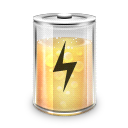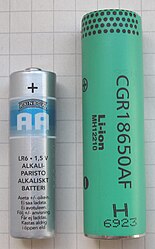Battery tech is advancing faster than ICE (Internal Combustion Engines).
~ Aristotle Sabouni
Created: 2022-12-24 |
Basics[edit | edit source]
The basics of how a battery works is as follows:
- A battery cell has two electrodes -- one is positively (+) charged (cathode) and the other negative (-) charged (anode), and they're contained in a chemical called an electrolyte (what you've probably heard as battery acid).
- A battery is one or many cells, wrapped in a case (plastic or metal), with terminals/tabs where + and - connects you to the cathode/anode respectively.
- Like Magnets, the + and - side (ions in them) want to be friends and pair up until they're all neutral and all that potential energy is back to its resting state. But they can't because the electrolyte won't let them (is in the way). So think of the - side as being under pressure and the + side is a vaccuum that wants to alleviate that pressure
- When you want current (to pull load), you connect the + to the - using a wire connected through a motor (or light). Think of the ions as water and the wire as a pipe... the negative (-) ions go flowing through the wire towards the positives (+)'s like water -- and they can turn a wheel (motor) that's in the way (or heat up a filament to create light).
- Once all the negatives are paired with positives, the pressure is gone and the battery is discharged (no more power).
- If you reverse the process and put current in the battery (push negatives to the negative side, and pull them from the positive side), you can depressurize the +/positive, and re-pressurize (charge) the -/negative, and like winding a rubber-band, it's ready to go again.
More[edit | edit source]
Here's a bit more to understand other terms you've probably heard:
- Each cell is weak, so you usually have many cells wired together.
- If you stack cells or batteries end to end (aka in series) with + connected to -, this increases the velocity of the current (ions are more desperate to quickly get over to their friends on the far side) and the volts/voltage is higher. Think of voltage as velocity or pressure.
- If you stack the cells or batteries side by side (aka in parallel) with all the +'s connected to each other, and all the -'s connected to each other, this doesn't change how quickly they move, but many more ions want to march side-by-side at the same speed and the amps/amperage is higher. Think of amps as volume.
- Either way, if there's enough time for 1 running to take one box across 100 times, or for 100 slow marchers to walk side by side with one box each, it was the same amount of work, or Watts/Wattage. Watts is just volts x amps, and we use it because we care about how much work can be done.
- We often measure potential of the battery, or rate of charging/discharging in Watt-Hours. Or since a single watt is small, kilowatt hours (Kilo meaning 1,000). My Tesla Battery is ≈78 kWh (or 78,000 Watt Hours); meaning it can either put out 7.8 Watts for 1,000 hours, or 78,000 Watts for 1 hours.
Packaging[edit | edit source]
Different battery cells are packaged together in different sizes, voltages and Amp Hours.
- Homes use battery sizes like AA (14.5 x 50.5mm), AAA (10.5 x 45.5mm), C (26x50mm), D (34x61mm) batteries, that are all 1.5 volts. But of course there are many more sizes and voltages.
- EVs became economical, when it was figured out that if you used enough commonly available laptop (High Powered Lithium Ion) batteries, it was enough to power a car for a few hundred miles of range. Those batteries came in a few sizes/formats as well -- generally their name/number is their size, and most are 3.7v (volts).
- 18650 - these were the most common cylindrical Lithium Ion (Lion) and are about 18 x 75mm so a bit bigger than the A batteries.
- 2170 (aka 21700) - 21x70mm's are a little larger still.
- 4680 - 48x80mm this is newer (Tesla designed) battery, about 25% bigger than a home D battery.
- Prismatic / Pouch - these batteries are custom little flat packs, that can be bundled together in a variety of ways (no standard format)
The bigger the battery, the fewer of them you have to put in a car to power it the same distance. This can cut on cost. This is why Tesla went from 18660 -> 20170s, and then designed their own 4680 (adding some structural rigidity to it, to help it strengthen the car). It allows for it to be easier to assemble cars, and thus they can make them cheaper.
Reliability is unknown. In theory, fewer parts to fail means more reliability. But the other argument is if one fails, depending on how/where, it has less an impact on the whole pack.
The other problem was that failures of Lithium Ion (Dendrites) can cause a battery to short and burn itself up. If batteries are too close together, you can get cascading failure and the whole pack goes. So a lot is done to isolate batteries from their neighbors so a single battery doesn't burn up the entire pack/car. (As well as a lot to distribute charge/discharge amongst all the batteries evenly, to give the pack the longest lifespan possible).
Chemistry[edit | edit source]
| 🗒️ Note: |
|---|
| Each time you charge a battery, the ions have to go somewhere. They normally swell the material, and when they discharge, the unswell. That can all happen inside the case, so you don't notice it. But the movement flexes the wires that connect the whole thing together, eventually causeing them to break. Another issues is some chemistries like Li-Ion can get dendrites which are like stalagmites in caves -- little growths after each charge/discharge. Eventually if they connect anode to cathod, you get a short and the battery fizzles out. |
There are a few different chemistries (what chemicals are active ingredients in batteries), and a few more that are emerging and will be coming to cars soon (but too expensive for now).
- Legacy These are how we make batteries inexpensively, but not enough density (or too much weight) for car applications:
- Lead-Acid -- these are typical batteries used to start (or run electronics) on internal combustion engine cars. Usually 12v (6 cells of 2 volts each), they have long lifespans, but are heavy.
- Zinc-carbon - this is the chemistry for normal home batteries. Cheap chemistry, reasonably long life, but single use disposable.
- Alkaline - these were the standard upgrade for ordinary Zinc-Carbon ones -- they have a longer shelf life, and will send out their voltage for much longer amount of time.
- NiCad (Nickel-cadmium) - these were rechargable toy batteries. Not as energy dense as Lion, but could be used for 100+ recharges. They had a quirk called "memory", and if you don't discharge them all the way, you wear them out faster.
- NiMh (Nickle-Metal-Hydride) - were more energy dense, didn't use the nasty chemical Cadmium (less polluting), and didn't have memory quirks. So was a replacement for NiCads, and was popular in electronics the 1990s until Li-Ions.
Lithium Ion (Li-ion)
These have about 2x the energy density as NiCads, and run higher voltages. They were commercialized in the 1990s (Sony). They are pretty good, and can work for up to 1,200-1,500 cycles if you manage their charge (don't charge/discharge fully). But wear can cause them to short and catch fire -- so this is managed/monitored by software.
| There are
different chemistries for Li-Ion batteries that use NCA (used in 18650's in the Model S or X) or NCM (use in 3, Y via 2170's or 4680's) for the cathode -- either Nickel-Cobalt-Magnese, or Nickel-Cobalt-Aluminum. NCM's have a little higher energy density. There's also LFP's as a different type of Li-Ion. |
- Lithium Iron Phosphate (LFP) or LiFePO4 This is a variant chemistry of Li-Ion battery cathode -- that gets to skip expensive and polluting cobalt. So is considered more "green". The downsides are they generally have lower energy density (used in standard/low range EVs, not the long range). But there's an upside, they don't care about full charge/discharge cycles. Generally with other Li-Ion batteries, it's better to keep the charge-discharge as small as possible (say 60% charge to 40% day to day, would provide a VERY long life). But LFP's don't seem to care about full charge/discharge as much. So you get a slightly shorter range, but can keep charged to 100% and run them to near 0% without as much wear as other Li-Ion batteries. These are also used in applications like home battery backup / solar or Power Plant storage, as they're a little cheaper, and heavier, but if you aren't moving them around and just mounting them to walls or ground, the weight is not a problem.
Sodium Ion
≈20% better density, cheaper materials, better low temp behavior. These are coming over the next couple years -- figure 2024-2026. Thus we'll see EVs improving for low temp applications and increasing in range a bit, if this chemistry is adopted.
| https://electrek.co/2020/12/15/sodium-ion-rechargeable-battery-density/ |
- Solid State / Glass Instead of using a liquid electrolyte there's ways to use solid silicon/glass as the electrolyte and/or anode. By using a pourous solid material, you get less flexing (wear), and less ability for dendrites, as well as much lower risk of short/fire. This translates to faster charging, longer lifecycles, and higher energy density -- all key to making EVs much better. Who doesn't want to increase range, decrease charge times, and have an EV that will last for 1M miles instead of 500K? The problems are that until they can scale, the costs are high, and it's a newer technology. Some car companies are betting on these coming online in 2025, others are more practically thinking towards 2030 before they become fully affordable.
Other[edit | edit source]
Active Cooling or new charge chemistries/mechanical designs
One problem with batteries and charge times have to do with pushing ions in, heats up the materials. (To the point where there can be fire risk if you push too far). Cars avoid that by keeping charging rates much slower than theoretical max. While EVs often have liquid cooling around the battery (like Tesla), some are working at integrating active cooling into the battery to allow faster charge times -- you waste a little electricity on cooling while charging, but that's a price many would pay on road-trips. Others are doing it with chemistries and/or mechanical design. But the idea is reducing charge times makes EVs more practical.
|
🔗 More
| |
🔗 Links
Tags: Electric Vehicles

